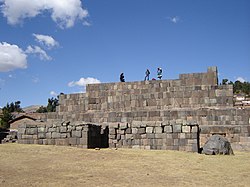
In the Inca Empire the ushnu (other spelling usnu, sometimes usñu) was an altar for cults to the deities, a throne for the Sapa Inca (emperor), an elevated place for judgment and a reviewing stand of military command.[1]: 69 In several cases the ushnu may have been used as a solar observatory.[2][3] Ushnus mark the center of plazas (main squares) of the Inca administrative centers all along the highland path of the Inca road system.
The ushnu had also the function of a basin with a drain for libations. During the most important Inca festivals such as the Situa in Cusco, the capital of the Inca empire, the emperor poured chicha (fermented maize beverage) into the top basin as an offer to his father the Sun god and those who attended the ceremonies could drink it at a lower outlet. Sacrifices were also held in proximity of or at the ushnu.[1]: 70 [4]: 274 While in the capital the ushnu was the axis of the Inca ceremonies, in the provinces of the empire they represented the central power and had a public role and were generally quite large structures, bigger than the ushnu in Cusco.[1]: 70
The shape of the ushnu varied in the vast extension of the Inca conquered territory. The one in Cusco, considered to be the center of the whole empire,[5] was a sugarloaf-shaped stone pillar, covered with gold. In the administrative centers, the ushnus had the shape of elevated platforms or truncated pyramids with one or more superposed platforms and a stairway climbing to the top.[1]: 70 Some ushnus, which have been the object of archaeological excavations, showed the existence of basins with drainage systems.[5][3]

It has been suggested by some scholars[4]: 275 [5] [6][2][7] that Intihuatanas (solar observatories), such as those found in Inca royal estates of Pisac and Tipón, and carved stones in Machu Picchu (Funerary stone), Chincero (PumaQaqa) and Sacsayhuamán (Throne of the Inca) could have been ushnus, due their use as seats and altars for religious cults.
As a social marker the ushnu provided an elevated position for the high level Inca nobility while common and non-Inca people stayed in a lower position in the plaza.[4]: 271 [5]
Notable ushnus are found in Vilcashuamán, Huánuco Pampa, Chinchero the three of them in Peru and Samaipata in Bolivia and Shincal de Quimivil in northern Argentina.
- ^ a b c d Hyslop, John (1990). Inka Settlement Planning - University of Texas Press - Austin ISBN 0-292-73852-8
- ^ a b Zuidema, R.Tom (1980). El Ushnu. In Revista de la universidad complutense n. 28 - pages 317-362- Spain
- ^ a b Hoopes, John W. (2009). "From Tiwanaku to Machu Picchu: Ushnus and the Architecture of Creation". In Margaret Young-Sánchez (ed.). Papers from the 2005 Mayer Center Symposium at the Denver Art Museum. Denver: Denver Art Museum. pp. 247–272. ISBN 978-0806199726.
- ^ a b c Gasparini, Graziano; Margolies, Luise (1977). Arquitectura inka - Centro de Investigaciones Históricas y Estéticas, Facultad de Arquitectura y Urbanismo Universidad Central de Venezuela - Caracas
- ^ a b c d Christie, Jessica Joyce (2007). Did The Inka Copy Cusco? An Answer Derived From an Architectural-Sculptural Model. Journal of Latin American and Caribbean Anthropology, Vol. 12, No.1, pp. 164–199 - doi:10.1525/jlaca.2007.12.1.16
- ^ Meyers, Albert (1998). Las Campañas Arqueológicas en Samaipata, 1994–1996. Segundo Informe de Trabajo - Sociedad de Investigacion del Arte Rupestre de Bolivia (SIARB) - Boletin 12:59–86. La Paz
- ^ Cavero Palomino, Yuri Igor (2015) Ushnus en la provincia de Vilcashuamán - in Peruvian archaeology volume 2, 2015 - Yamagata University institute of Nasca